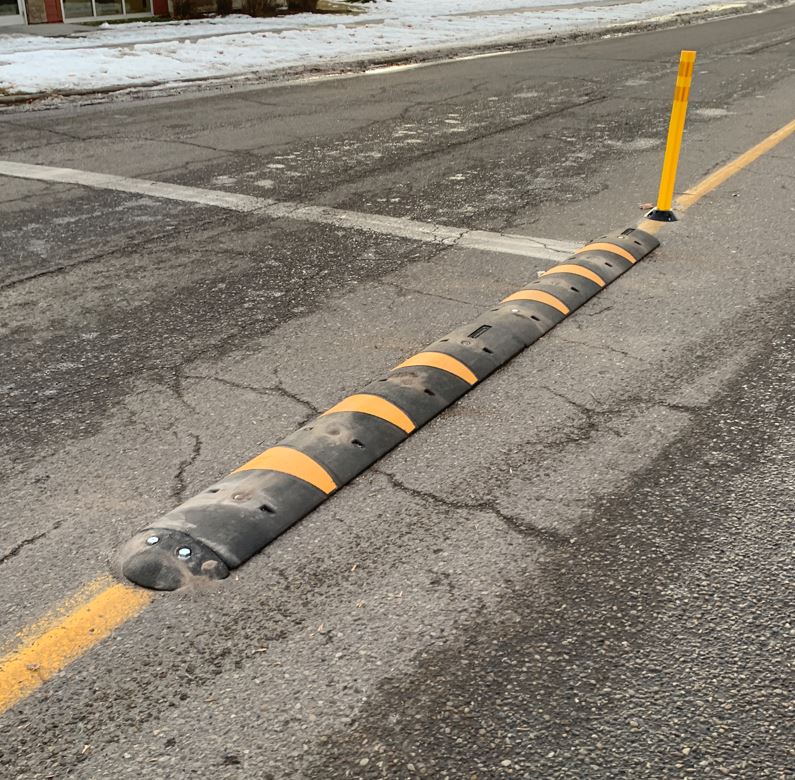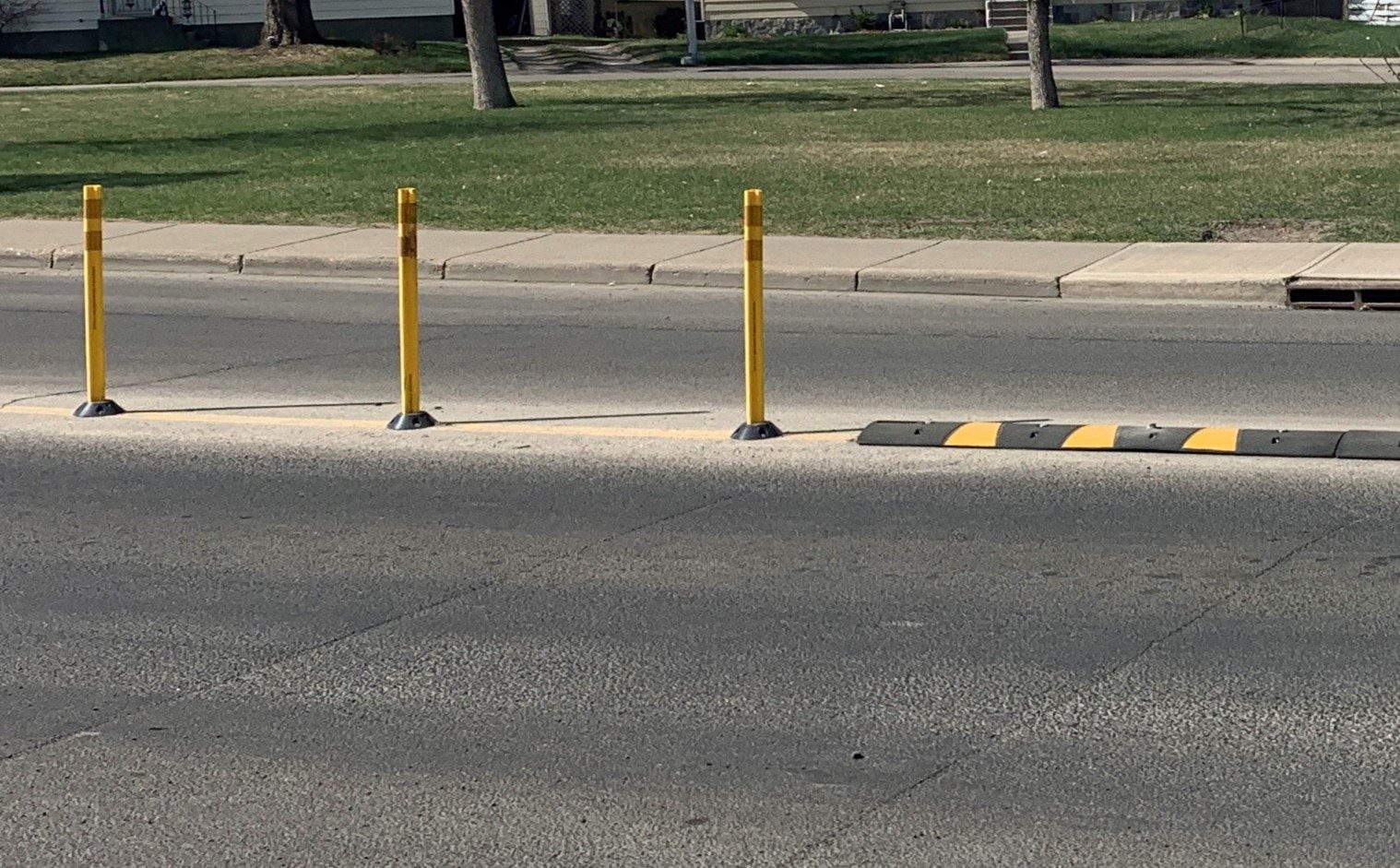Left Turn Calming Pilot Project
Project overview
Left turn calming (also called centerline hardening) consists of temporary rubber speed bumps used to enhance roadway centerlines and improve pedestrian safety. The intent of left turn calming is to encourage drivers to make slower left turns. It also increases their awareness of other road users in the process.
Left turn calming has been implemented in other North American cities, including Toronto and New York City, with promising results for improving pedestrian safety.
This year, left turn calming will be added where high-speed left turns are affecting pedestrian safety:
- 12 Avenue S.E. and 1 Street S.E. (to be added in Fall 2024)
Between 2022-2023, left turn calming was added to intersections at:
- Northmount Drive N.W. and 4 Street N.W. (added in Fall 2022)
- 26 Avenue S.E. and 36 Street S.E. (added in Winter 2022)
- 58 Avenue S.W. and 5 Street S.W. (added in Summer 2023)
How do they work
Rubber speed bumps are overlaid on top of the roadway centerline. These materials have reflective stripes attached to make them distinct to drivers and other road users. There are also yellow plastic posts installed in front of the speed bumps that will be seen by drivers as they approach the intersection. Drivers making a left turn at the intersection should slow down to an appropriate speed, so that they can turn into the proper lane while driving around the speed bumps.
By turning at a lower speed, drivers are also likely to complete their turn at a more perpendicular angle that allows for better visibility of pedestrians on both ends of the crosswalk. Larger vehicles may drive over the speed bumps, as required to navigate the intersection.
The design of the speed bumps ensures vehicles will still have enough room to turn and traffic flow will not be significantly affected. Additionally, the rubber speed bumps are designed with a low height so that they don’t pose any significant danger if driven over by vehicles.

Findings
Improvements in driver behavior were observed at the initial three project locations. Left turn calming was found to have reduced illegal turns by more than 20 per cent for some locations. These illegal left turns were either crossing over the painted centreline or turning into the second lane instead of the nearest lane. Increased driver awareness and reduction in turning speeds were also observed at all locations.
Next steps
The existing left turn calming treatments will remain in place as they have demonstrated tangible safety benefits. Additional locations may be selected for left turn calming treatment in the near future. These locations will be identified through engineering studies. The City will continue to monitor existing locations to assess the design and identify any potential issues that may arise.
Frequently asked questions
Has The City considered the impacts of winter maintenance on this project?
Winter maintenance is an important consideration for this project. In recent months, The City had collected feedback from our maintenance staff on potential winter maintenance issues. As a result of these discussions, The City will be closely monitoring these locations for winter impacts such as snow buildup. At the same time, our maintenance staff will continue their work to ensure effective snow and ice control at these locations.
How were the collision data and driver behaviors reviewed to assess pedestrian safety?
Collision data from recent years were reviewed to identify pedestrian collisions involving left turning vehicles. There were multiple collisions of this type that often resulted in pedestrian injuries. Driver behaviors were reviewed using video footage from intersection cameras and on-site observations by City staff. The footage and observations showed many instances of vehicles turning left at high speeds and crossing over the painted centerline. Drivers making these high-speed turns will have less time to react and stop for pedestrians in the crosswalk. Both the collision data and observed driver behaviors showed significant pedestrian safety risks at these intersections.
What is the purpose of the yellow plastic posts installed in front of the speed bumps?
The yellow plastic posts indicate to drivers that they are approaching the speed bumps. During winter, snow may cover the speed bumps and make it difficult for vehicles to drive around them. The yellow plastic posts are three feet tall and will remain visible to drivers even when there is significant snow buildup on the roadway.
Do the speed bumps affect vehicles travelling through the intersection without turning?
The speed bumps do not significantly affect vehicle that are travelling through the intersection without turning left. The speed bumps are designed with a narrow width and do not significantly reduce the width of the travel lanes on either side of the centerline.
Has The City considered impacts of the speed bumps to elderly and visually impaired pedestrians?
The speed bump installations were designed to minimize impacts to elderly and visually impaired pedestrians. All speed bumps have distinctive yellow stripes to improve their visibility. Additionally, there is some space between the speed bump and edge of the crosswalk. This space ensures the speed bumps do not impact pedestrians walking within the crosswalk.
Why were speed bumps chosen over other treatments such as pavement markings or concrete medians?
As a left turn calming treatment, rubber speed bumps are inexpensive, quick to install while still providing the desired benefits. Since the speed bumps were installed, improvements in driver behavior were observed at all project locations. More drivers were making left turns at a slower, more appropriate speed that avoids crossing over the painted centerline. Such improvements would be difficult to achieve with only pavement markings that change the stopping or turning position of vehicles. Pavement markings are flush with the road surface and can become easy to ignore for drivers. In contrast, the speed bumps have a low raised profile that is much more visible to drivers. Compared to permanent measures such as concrete medians, speed bumps have much lower installation and repair costs, minimal installation time, and do not require narrowing of travel lanes.
Contact us
To learn more about the project or give feedback, contact 311 online.


